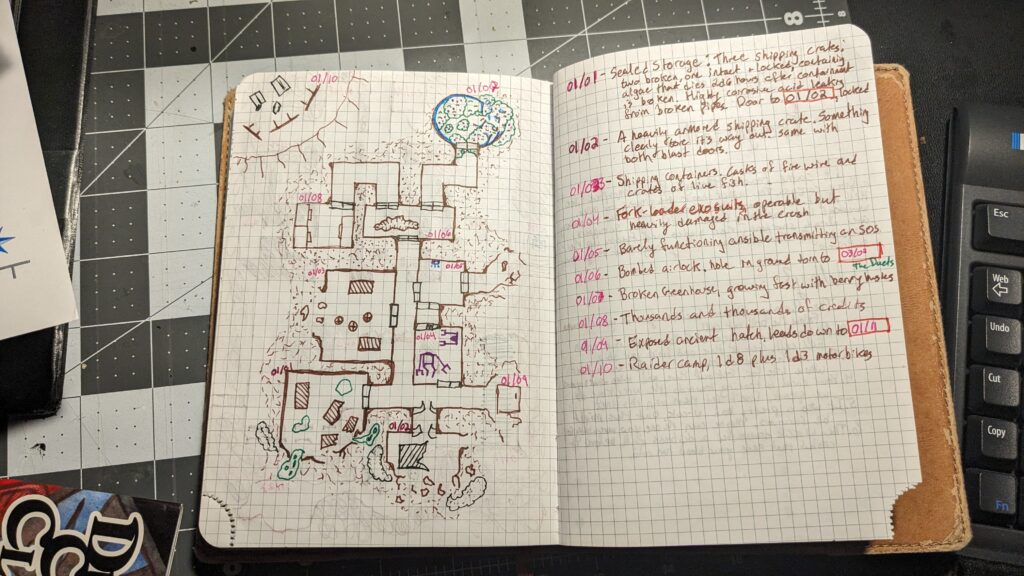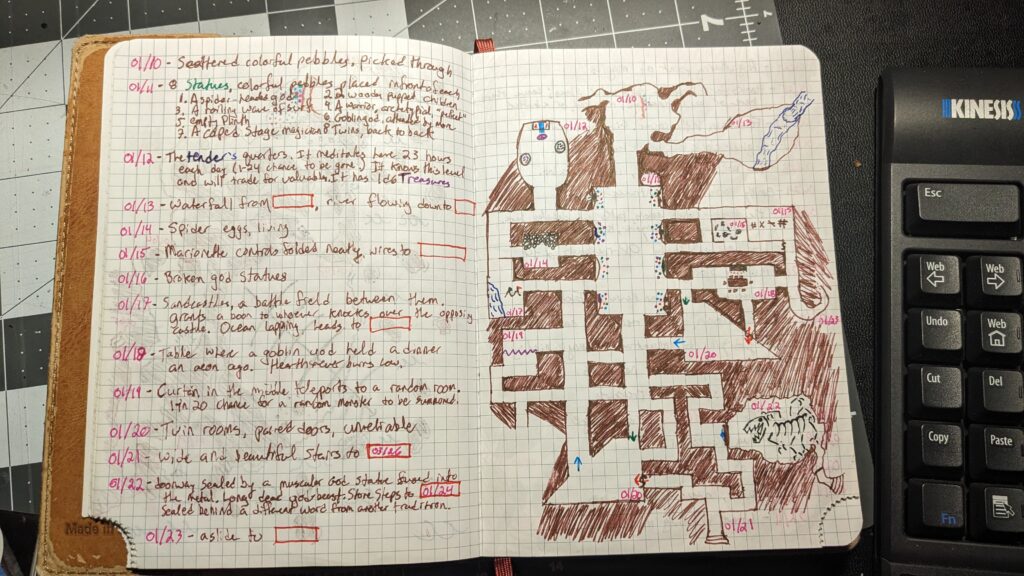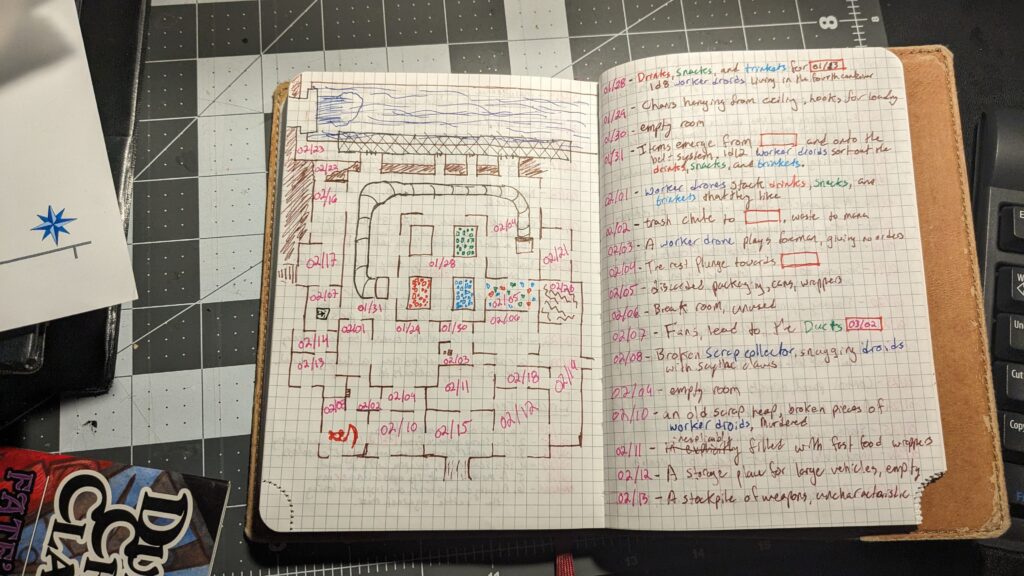Like so many others, I saw Sean McCoy’s #dungeon23 post on Twitter last December and got instantly excited. It’s such a tantalizing concept, and it sounds so easy… just one room a day, how hard could it be? I dug up my favorite leather journal cover and found a great little grid book to fit inside. But what kind of dungeon to create? Sci-fi? Fantasy? Well hell, I thought, why not both? I set out to do #dungeon23 as a double-faced project; a fantasy dungeon starting in the front of the book, a sci-fi dungeon starting in the back, and somewhere in the mythic underworld in the middle they’d mix and mingle into something horrible and new. Two rooms each day, one in each side of the journal.
The last date in my journal is April 16th.

My final #dungeon 23 consists of:
- 8 Levels
- 135 rooms
- 2 starting prompts, each with 6 hooks
- 12 random encounters
- 1 mysterious in-between
I’m honestly proud I did anything with this project; 135 rooms is a lot, even if it’s nowhere close to the 720 I was hoping for. Some are simple (03/06 – stairs up to 01/21), others are more complex (01/17 – Sandcastles, a battlefield between them. Grants a boon to whoever knocks over the opposing castle. Ocean lapping, leads to ??/??). Theoretically, I could run this dungeon for several sessions and not run out of things to do. Would it be any good? Who knows. But it could be done.
That being said, I ultimately failed at achieving my goal. That’s ok, failure happens. But I would like to learn something from this and put it into words for whatever big project I do next. Maybe you’ll learn a thing or two from my failure as well!
I Left Room To Settle – At first, I was working on two rooms each day, with whatever treasure, denizens, traps, etc I wanted to put in them. But eventually I found myself compromising. “Oh, I’ll just do one room today. Maybe I’ll alternate between the sci-fi and the fantasy sides” or “Today I’ll do a random encounter instead of filling a room.” Many of my listed dates were actually all crammed in on one day as I scrambled to play catch-up. Each of these concessions meant I was making the task easier, but I also felt like I was failing long before I finally gave up altogether. By leaving myself room to negotiate, to do less, I opened the door to fail. If I were to do this again, I’d start at the bare minimum. Add one thing to the dungeon each day. Room, treasure, encounter table, monster, rumor, hook, anything. I think I knew somewhere in my head that two rooms every day was a goal outside my capacity, and starting with something more realistic would have made me more likely to stick with it.
I Didn’t Know Jack About Dungeons – This is a big one. I thought I could write a dungeon, but in retrospect, I didn’t even know what a good dungeon was. I was only just starting to get into the shallows of OSR/old-school/whatever-you-want-to-call-it kinds of games at the end of last year. I grew up playing AD&D and OD&D, sure, but I was not paying enough attention to what made a great dungeon. When I found indie RPGs, I ran away from D&D and anything that looked remotely like it. It wasn’t until I read Luke Gearing’s Volume 2: Monsters & in 2022 that I really started getting into the old-school style. So going into #dungeon23, I didn’t really have an appreciation for the kind of emergent stories that come out of a great dungeon. I wasn’t familiar with the idea of a funhouse dungeon where not all the rooms make perfect, logical sense. I was tied to a very specific stylistic vision of what a dungeon needed to be, and that narrow view put a real limit on my ability to just write. Now I’ve read such adventures as Tom Moldvay’s Castle Amber and Harley Stroh’s Fate’s Fell Hand and great blog posts like Two Week Megadungeon from Papers & Pencils, and I still feel like I’m only probing the surface of what dungeon design can be. So I approached this project without really knowing what it was I was doing or how to do it. Nick LS Whelan puts it beautifully in the aforementioned Two Week Megadungeon blog post:
“If you haven’t already, you should free yourself from the expectation that your megadungeon’s layout will make logical sense. That’s impossible to accomplish, and boring to attempt…. My goal is to create a wild network of weirdness first, then once that’s done I can let my brain off the leash to do its pattern matching thing. This produces wildly more interesting results for me.”
https://www.paperspencils.com/two-week-megadungeon/
Not only had I not read many other dungeons, I had never run a megadungeon before. Even now, I’ve only run a few sessions of what could be considered old-school play; a few sessions of Luke Gearing’s Wolves Upon the Coast (I’ll be writing more about that this year!) and a very fun, very casual OD&D session for friends on New Year’s Eve. So not only did I not know how to design a megadungoen, I didn’t even know what to shoot for to make it fun to play or to run.
Part of me wants to take away from this that it’s hard to commit to doing something every day if you’re also learning how to do that thing. But I think the more important lesson is that it’s good to know what you want the thing to look like before you commit to doing it, even if you don’t yet know how to achieve that. If I had more experience running dungeons, it would have been a lot easier to backwards engineer and learn the “how.”
I Got Bored – A dungeon is a really particular kind of thing. Even with the variety afforded by doing both fantasy and sci-fi, I remember swiftly feeling bored with what went into writing for this project. This very much relates to the previous point – dungeons aren’t my primary way of working with RPGs, so I got really burnt out on forcing myself to work on something I wasn’t completely obsessed with. I liked the idea of having a 700+ room dungeon that I could run, but when faced with the idea of actually writing all 700 of those rooms, I balked. If I’m going to do something every single day, it should be something I really like. Not something I want to like or think I might like, but something I know I love. If I want to learn to like something, or I want to try something out, there’s no use making a year-long commitment to that thing.




Reflections
So that’s #dungeon23! I wrote a heck of a lot more dungeon rooms than I ever have before. I read a lot of other cool #dungeon23 posts both before and after I gave up. I have also started using this little journal for other dungeon stuff. Earlier this fall, I used the Songbirds 2e random dungeon generator to fill up a big old page of dungeon. I found myself using a lot of the lessons learned from the few months I did spend on #dungeon23. I also copied the sample unstocked dungeon from the 1983 D&D Red Box starter set and filled that, then went on to play some of that dungeon with my partner and a group of really good friends. I also wrote a small dungeon zine for my roommate’s birthday, full of small inside jokes and prizes. I really don’t think I’d be as interested in old-school play as I am now without the time spent writing dungeon floors in the first few months of 2023. It gave me a much deeper appreciation for the people who do write cool, readable, usable, and evocative dungeons. It helped me form an opinion on what I like and what I don’t when it comes to dungeon writing. And it gave me this set of takeaways, which I would now like to apply to my goal for 2024.
In 2024, I want to publish something on this site every weekday. I’m setting out to do this in the wake of quitting my job as the Lead Comics/Gaming/Anime editor at CBR, which has left me wanting to write more. So, my three lessons:
No Room To Settle – At first, I wanted it to be every day; I’m preemptively cutting that back to every weekday. Blog posts don’t have to be about anything in particular, anything is on the table. I don’t have to write every day; I can schedule publishes in advance. All of these are exceptions I could see myself making down the road, so I’m making them part of the rules now.
I Understand My Goal – I’m going to be doing a lot of different kinds of things on this blog I think, from reviews to critique to design to play reports. I don’t necessarily know how to do all those things yet, but I have a much better idea of what I want them to look like. I’d like my reviews and criticism to be thought-provoking. I’d like my design to bring joy (bonus points if you actually use/play any of it). I want my play reports to be entertaining to read and encourage you to play games of your own.
Whatever I Want It To Be – I’m hoping that by keeping a very wide range of acceptable topics, I’ll keep this entertaining for myself. I won’t have to force myself to care about the topic; the topics will be determined by what I’m excited about. In this way, I’m hoping never to get bored.
I’m hoping this will be the year I develop a reliable creative practice, and I think using these principles will help move closer to that goal. Thanks for reading my #dungeon23 recap, I’d love to hear how yours went in the comments!
– Declan
I didn’t participate in #d23, but I’m glad I could be part of your journey into dungeon play. The map and key in your notebook are so attractive compared to every dungeon I’ve ever written!
Thank you very much! Reading your blog helped a lot of things click.